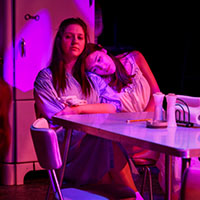Tag: Rachel Gluck
Review: ‘Crimes of the Heart’ at Curio Theatre Company
Curio Theatre Company’s production of Beth Henley’s Pulitzer Prize winning tragicomedy, Crimes of the Heart, is the dark and hilarious tale of the Magraths...
Review: ‘Antagonyms’ at Curio Theatre Company
An antagonym is a word with two opposite meanings, such as “left” which can mean “remaining” or “departed.” Rachel Gluck’s world premiere Antagonyms at...
‘Machinal’: An Expressionistic Masterpiece: Interview With Director Brenna Geffers, Part 2
Machinal by Sophie Treadwell, considered one of the most important Expressionist plays in the United States, premiered on Broadway in 1928. Inspired by the life...
‘The Bald Soprano’ at Curio Theatre Company in Philadelphia
After a somber Handmaid’s Tale, Curio Theatre Company sure changes directions with Eugene Ionesco’s hilariously absurd The Bald Soprano.
Director Charlotte Northeast updates this 1950's...


